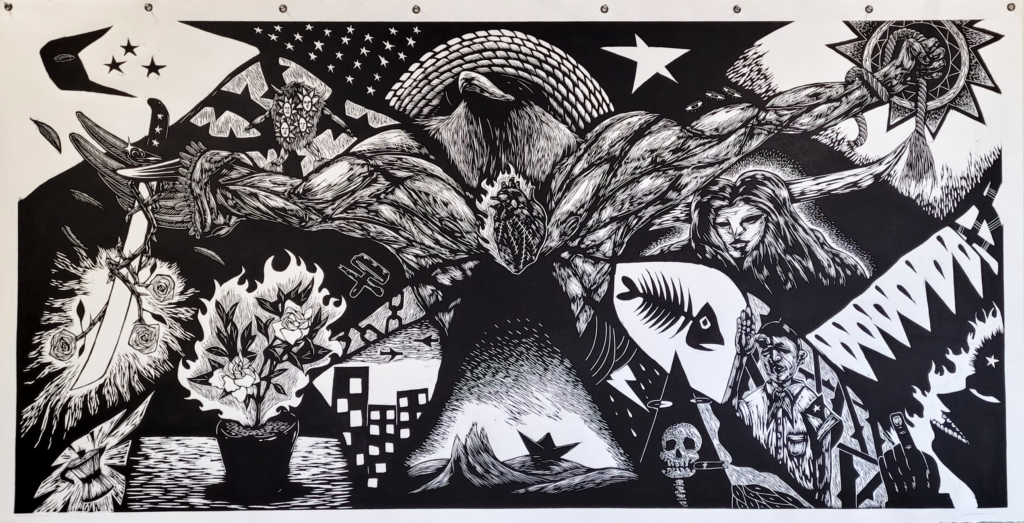
This woodcut was printed from an 8×4 foot mdf block. It was designed and printed in preparation for a show named Nuestra Tierra (Our Land), which was co-curated by Joseph Velasquez, and which featured Hispanic artists who were immigrants or children of immigrants, and who grappled with the idea of calling America home. For this piece I meditated on my experience in the United States as an immigrant, and my transformation from a Cuban boy into a Cuban-American man.
As a 16-year old teenager arriving in the US, my first reaction was to try to be as “American” as possible in order to fit in and not be so lonely. However, as I unconsciously developed a persona crafted in order to be able to mingle with this new culture, I felt my own old self reject this new way of life pretty strongly, eventually leading into depression and lack of identity. I felt undermined trying to be someone I was not, acting like a clown in order to be liked and respected, afraid that my own Cuban culture wouldn’t be accepted for some reason.
As a 27 year old man I find myself craving my culture more than ever. Despite the fact that I don’t necessarily love my country, I do love my culture and my people. Now after years of damage to my own Cuban identity, I’m trying to regain some of my old self back. In the process I’ve come to realize that this is impossible, since 11 years of experiences in America have shaped me into a new man, and now I’m somewhere in-between Cuba and America, a place where I can be myself and be comfortable, and most importantly a unique individual.
This piece features a sort of monstrosity in the center of the composition. A man being shattered and fragmented, pulled apart by experiences and identity. The man has a body that is not realistic or anatomically possible, representing the process of transforming into something new. The process of transformation looks painful, or at least very uncomfortable. The head is no longer human. It has taken the identity of a bird that’s not quite a bald eagle, but something strange, like a mockery, something that tried to be a bald eagle but stopped short of completing the transformation. The hat that is wearing is a straw hat commonly used by Cuban farmers and a symbol of the Mambí spirit, but the hat looks bigger and it doesn’t quite fit the man. At the center there’s a burning heart. The symbol of hot-blooded Latinos. The heart is in flames, but it’s also scarred and damaged. Below there’s a paper boat floating in rough waves, which symbolizes both the “Barquito de Papel” Cuban children’s song, as well as all the Cubans who crossed the sea to escape the island. My father is one of these brave people.
Spread around the composition are several symbols that represent my struggle. The gardenias on fire is a symbol of my culture. The Dos Gardenias song is a Cuban classic, and I decided to lit them on fire to represent both my dying knowledge of Cuban culture, as well as a religious metaphor. The Machete is a representation of the Mambí spirit as well, and I covered it in roses to represent that the violence that comes from such a blade is covered and rendered useless by beauty. The pioneer saluting the flag is a representation of child brain-washing in Communism, and destruction of the unique individual. Next to him you see the dictator shaking his finger. Both the Sun and Moon, as well as the Painbringer and Gratitudebringer are here, to showcase my modern sensibilities, and the content of my work as an artist, which is part of who I am today, as well as to show that time is still passing and that I have felt a great deal of pain and gratitude since I’ve come to America.
